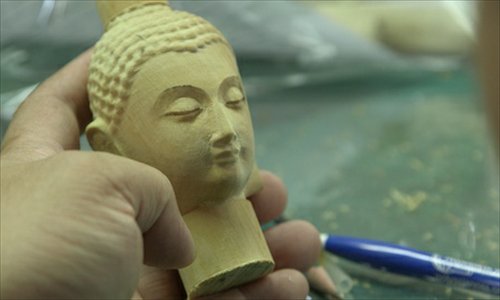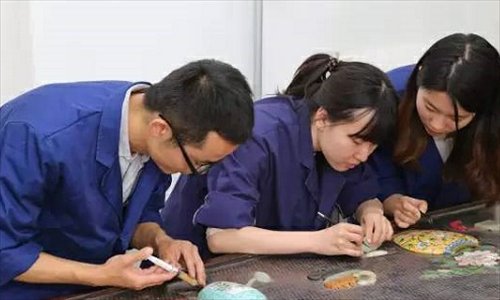Antique repair documentary becomes unexpected hit among China’s youth


Scenes from Masters of the Forbidden City
"Master Wang is so handsome!"
"Master Wang marry me!"
Seeing comments like these flying across the screen on bilibili.com, you would probably think you were about to watch a video of some young idol that all the kids are crazy about.
However, you couldn't be farther from the truth, as these comments were actually left behind on a documentary about the restoration of antiques.
The Master Wang in question is Wang Jin, a restoration expert who repairs the antique clocks in the Palace Museum, located in Beijing's Forbidden City.
What inspired these types of comments is not just Wang's dashing looks, but also his craftsmanship and dedication.
If it were not for the documentary Masters of the Forbidden City and its coverage of restorers painstaking work repairing the precious antiques in the Palace Museum, the public may never have gotten the chance to get to know the mysterious antique restorers behind the Forbidden City's red walls.
However, nobody expected that this China Central Television documentary would become such a big hit among young people.
When it first aired on CCTV 9 in January, the show didn't trigger much discussion, but after a month the show suddenly went viral on bilibili.com, a popular website for anime, comics and games. Currently, the show holds a 9.5 out of 10 score on the site, beating out popular TV dramas such as Nirvana in Fire.
The three-episode documentary is divided into three different categories, with the first episode covering bronze wares, clocks and ceramics; the second wood antiques, lacquer wares and embroidery and the third about restoring painting and calligraphy works.
Not like you imagined
"I'm shocked by the master's temperament. He casually says, 'I'll drop by Shoukang Palace' like he's visiting his neighbors," netizen Nixide Goumao commented on the program, adding that he finds it difficult to stay calm while watching it.
Unlike the stuffy experts sitting around being serious that exist in most people's imaginations, the program shows off the vigor and enthusiasm of the restorers as they come face to face with antiques.
The documentary has dispelled many audiences' preconceptions about antique restorers, allowing them to realize that they are not old and dull professors, but people in their 40s, 30s and even 20s who can be quite pleasing to the eye.
Considering the delicate nature of their work with the country's national treasures, these restorers must follow strict 9 to 5 schedules. No overtime is allowed, since working tired may lead to a mistake that could destroy a piece of irreplaceable history.
The show also has some young people asking the question: "Is it too late to change my job?"
Reaching out to youth
This is not the first time that the Palace Museum has captured the attention of China's youth. The museum has recently introduced several new attempts to connect to younger generations. No matter if it's the museum's many advanced smartphone Apps, cute souvenirs or light-hearted way of telling stories, they have all made the profound culture that exists in the Forbidden City a bit closer to younger generations.
In a review of the show on media site douban.com, one reviewer commented: "Take two hours between watching British, American and Japanese TV series, or watch a few less domestic TV series about mind games between mother-in-laws and daughter-in-laws, to watch this documentary. You will be deeply touched by a group of people and you will be proud of your country."
'A human touch'
The first motto masters teach their students is "Relics can only be repaired through patience."
While patience is an essential part of the restoration process, the same could be said for the making of this documentary. Before they began shooting in April of last year, the production team spent five years researching the Forbidden City to produce a report that was more than 100,000 words long and covered every detail of these restorers' lives and jobs.
"When things started, I asked myself how I could make people outside this field, especially young people, follow this documentary like they follow South Korean or Western TV shows or Japanese anime," Ye Jun, one of the show's two directors told The Paper in an interview.
"If people come to think this work is beautiful and valuable, or if somebody is inspired to learn such a skill, I'll be very honored."
Ye said ever since he started working in film, the films that he enjoys the most are genre films such as Inception and Interstellar - mainstream blockbusters that he thinks also feel like inde films that straddle the boundary between art and commercial movies.
So when he chose to make such a documentary, he decided to make sure it looked beautiful and was edited to create a sense of rhythm.
While the show focuses on the skill required to restore antiques, it also delves into the lives of the restorers and explores their personalities.
One scene that has been greatly admired by netizens features a young female restorer riding a bicycle through the empty Forbidden City on a Monday as a narrator says: " The last person to do this was Puyi (the last emperor of the Qing Dynasty 1644-1911)."
"It was randomly shot by our photographer, but we added the voice-over on purpose. If this film only introduces how they repair things without revealing details about their lives like these, it would be boring. With this, there's a human touch," Ye explained.
Global Times
Newspaper headline: ‘Masters of the Forbidden City’